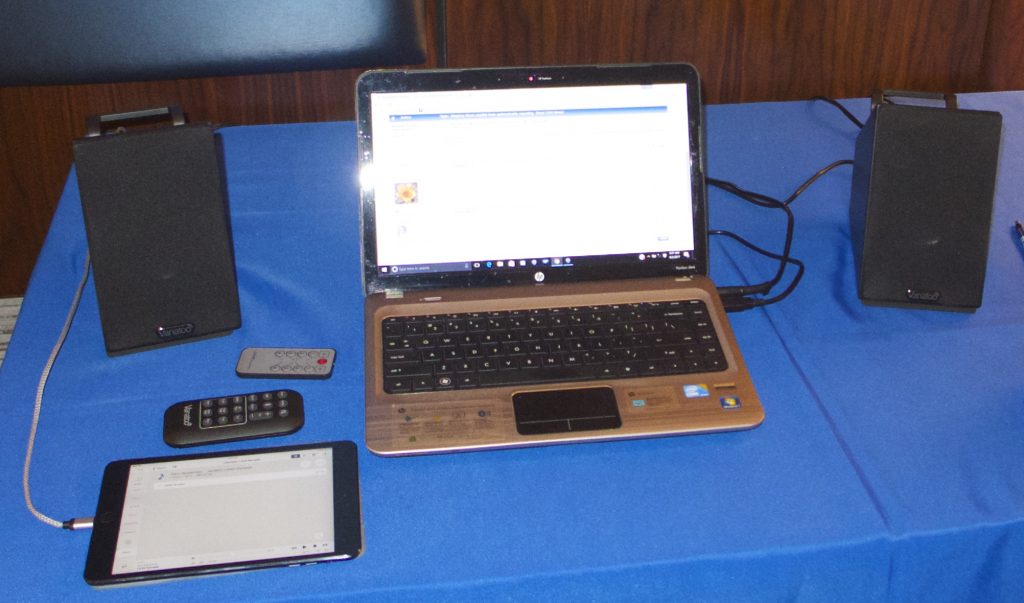
At the LA Audio Show, it was very evident that the guys from Vanatoo were excited and genuinely proud of their new little speaker. It’s named the Transparent Zero as it is the little brother of their very successful Transparent One powered speaker that I reviewed about three years ago. In their room, the speakers were stand-mounted and well out from the wall. They sounded surprisingly full and spacious. I couldn’t believe that someone could get sound this good for $359. By the way, at the time of this review, they still have an introductory price of $299.
Description
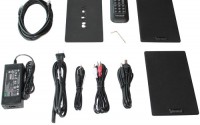
When I unpacked the T0 and looked at the front of the speaker sans grill, I was impressed, but there was one odd elephant in the room, or maybe I should say in the packing box. So, let’s address it before I forget; why is there a bracket attached above the passive radiator? It’s because you can set the speaker so that it fires up toward the listener or flip it over, and the bracket allows it to sit up straight. You can take the bracket off if you are using it firing up toward you, but I found it made a nice handle for portability.
Not many speakers, if any, in this price range have such a nice one-inch soft dome tweeter. I don’t know why the one-inch tweeter on the T0 looks so much bigger than the ¾-inch one on the HD3s, but it does, and it sounds much smoother as well. The midrange/bass driver also looks impressive. It is a custom aluminum four-inch driver compared to the 2.75-inch Kevlar woofers in the Audioengine HD3. Now don’t misunderstand me, the HD3 is a very refined little speaker, but the T0 simply ups the ante for an under $500 powered speaker.
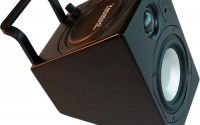
It isn’t just that you get this great sound from a $359 speaker, it’s everything else it incorporates. Each speaker’s four-inch aluminum mid/bass drivers and one-inch soft dome tweeters are bi-amped by a 48-watt channel amplifier with a digitally active crossover network. The crossover is a DSP-based 8th-Order Linkwitz Riley at 2200 Hz. The built-in analog and digital inputs allow one to directly connect to almost any source, and there is also a built-in Bluetooth interface for wireless connection to any phone or laptop computer.
The way they connect from one speaker to the other is different from the T0 than with most powered speakers. They use what looks like an Ethernet cable. In reality, it’s not an Ethernet but a ten-conductor cable with RJ50 connectors. This allows three pairs of conductors to be used on the woofer and two pairs on the tweeter. The result is greater redundancy and lower cable resistance. If you lose your cable, an RJ45 Ethernet cable will plug into and work until you can replace the cable.
The powered speaker is set up from the factory to be the right speaker, but you can change this if you desire. The rear of the powered speaker has two rows of inputs, outputs, and switches. The top row has the input for the power cord, the output to connect the other speaker, and a subwoofer output. The bottom row has a pair/program button and a V-T-B switch. The volume control can be used to set volume, bass, treble and a myriad of other things as explained in the owner’s manual. Next, to the V-T-B switch is the USB input, the analog input, and an optical input. The volume control is located just below the passive driver on the powered speaker.
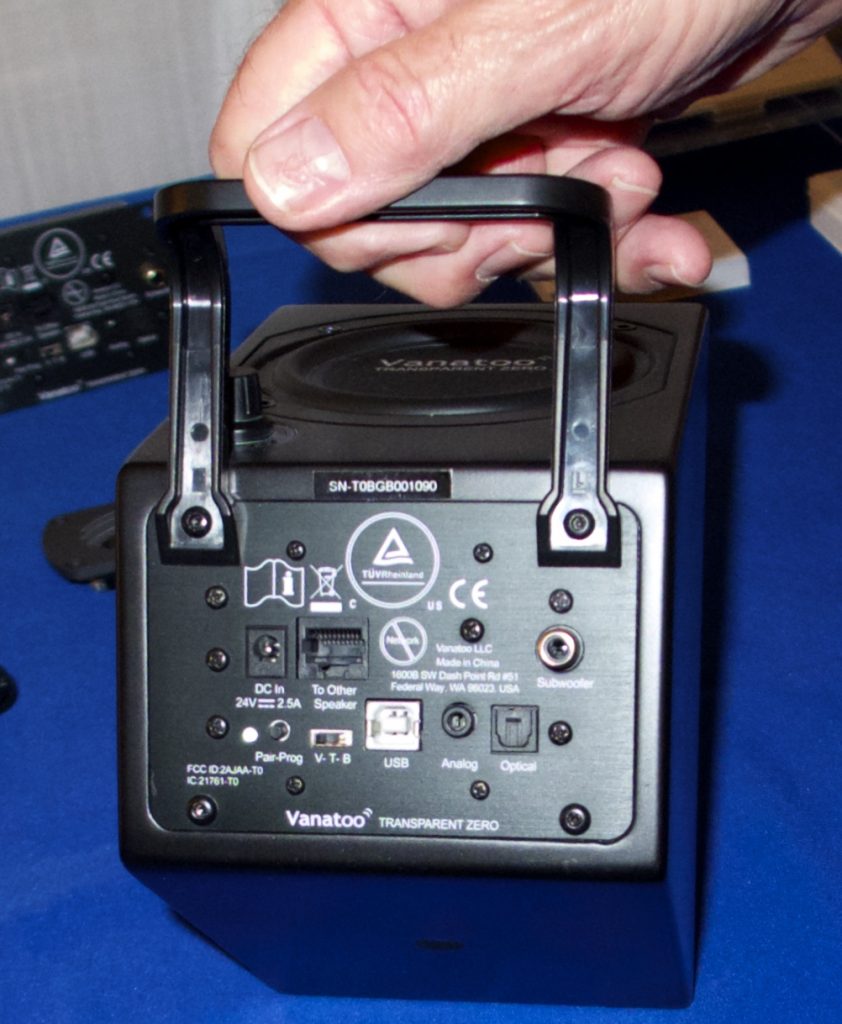
The T0 is one versatile all-in-one music system. Through their unique physical design and their abundantly adjustable DSP system, you can set them up as desktop speakers, computer speakers, TV speakers or stand-mounted speakers as well as adjust the DSP so that they can work best with a subwoofer. They have an excellent online instruction manual that tells you how to get the best out of this versatile speaker.
Remote Control
 The T0 comes with a remote control that lets you utilize most of their versatile features from your chair. For example, there is an Auto Command that enables the AutoInput Switching algorithm and automatically selects the input to play. There are also buttons for Analog, USB, Bluetooth and Optical Commands. When either the Analog, USB, Bluetooth, or Optical input selection commands are sent, the amplifier will disable the Auto Input Switching algorithm and switch the input to the input you select. If, for example, music is being received by the Bluetooth receiver and no music is being received by the optical input and you select Optical from the remote control, the result will be that no music will be heard from the speakers.
The T0 comes with a remote control that lets you utilize most of their versatile features from your chair. For example, there is an Auto Command that enables the AutoInput Switching algorithm and automatically selects the input to play. There are also buttons for Analog, USB, Bluetooth and Optical Commands. When either the Analog, USB, Bluetooth, or Optical input selection commands are sent, the amplifier will disable the Auto Input Switching algorithm and switch the input to the input you select. If, for example, music is being received by the Bluetooth receiver and no music is being received by the optical input and you select Optical from the remote control, the result will be that no music will be heard from the speakers.
As another example, there is an Enable Command that when sent to the amplifier will start an Enable Key 15-second countdown timer. During that 15 seconds, the amplifier will respond to the Bluetooth Pair commands, Treble commands, and Bass commands. Any commands received from the BT Pair, Treble commands, or Bass commands during the 15 seconds will cause the 15-second countdown timer to be reset to 15 seconds and restart the countdown as well as executing the requested action as described below. There are many other things you can do with the remote, that are spelled out plainly in the online manual. Still, none of this technological ingenuity would matter to me if the speakers didn’t sound good; so, let’s talk about how they sound.
Listening
As good as the Transparent Zeros sounded at the LA show, I was not prepared for how they would sound in my home. When the UPS man dropped them off, I slid the box to the side and didn’t open them for a few days. Then one afternoon I took them to the office where Becky was working and told her I wanted to swap out the Audioengine HD3s with the Vanatoo Transparent Zeros so that they could break in for a while. It took less than five minutes to do this. I didn’t change anything from the factory presets. When we turned them on we just looked at each other with amazement. I then asked her if they sounded as much better as I thought they were. She answered, “Oh yeah!”
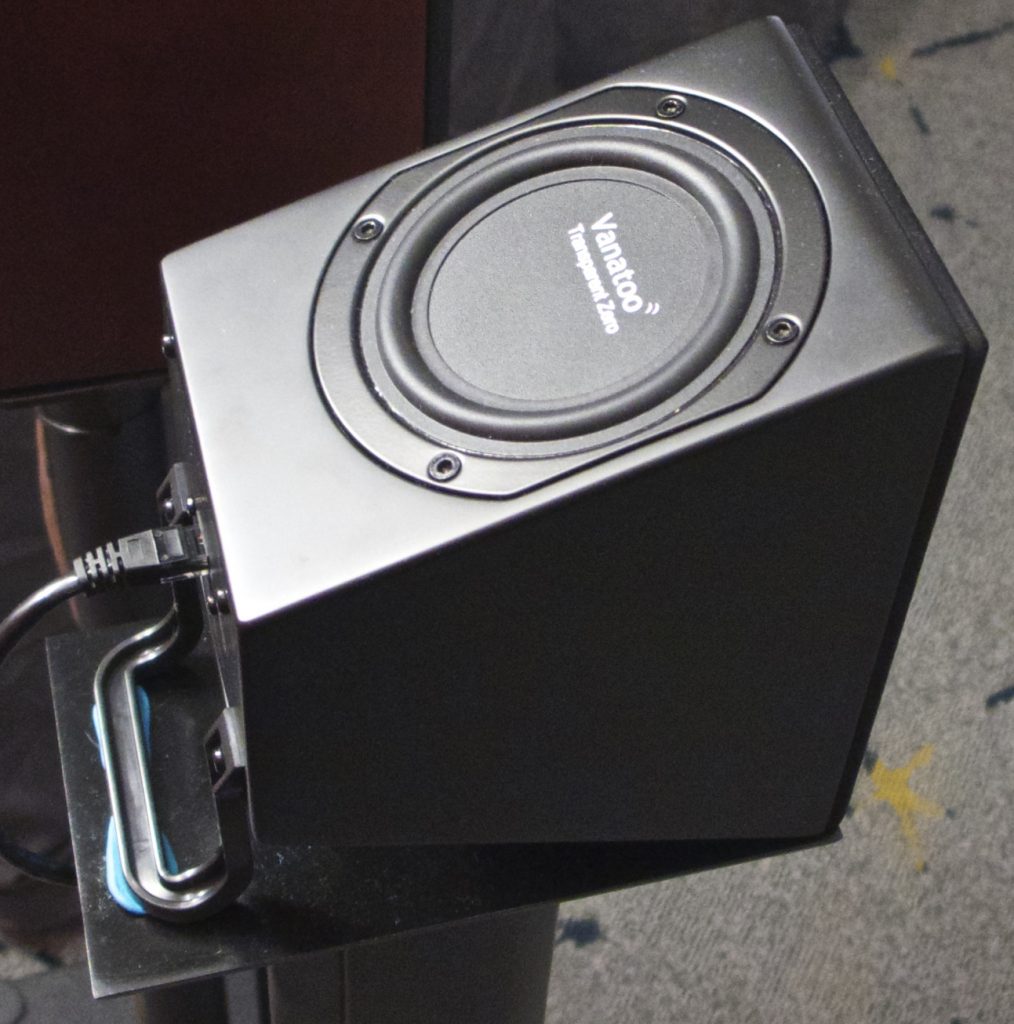 I listened to television, movies, the blues, Alison Krauss, Willie Nelson, Starker on cello and much more on the Transparent Zeros. The sound was very good. No, they are not as refined or detailed as the $2,300 Audience ClairAudient 1+1 V2+. Still, this speaker can play music with wonderful, rich tones. Yes, there is a little elevation in the lower midrange, just enough to make them sound more natural than with most small speakers, either powered or passive. The speakers were also easy to listen to for long periods of time. They never sounded stressed or strained.
I listened to television, movies, the blues, Alison Krauss, Willie Nelson, Starker on cello and much more on the Transparent Zeros. The sound was very good. No, they are not as refined or detailed as the $2,300 Audience ClairAudient 1+1 V2+. Still, this speaker can play music with wonderful, rich tones. Yes, there is a little elevation in the lower midrange, just enough to make them sound more natural than with most small speakers, either powered or passive. The speakers were also easy to listen to for long periods of time. They never sounded stressed or strained.
If you set them up a few feet apart and a little away from the walls, they will create a really good soundstage and the imaging within the soundstage is very good. If you put them on stands away from the wall, the soundstage and imaging are even better. You can set up the DSP for being on stands away from the wall, and the bass is surprisingly good. It extends well below what anyone would expect from such a small speaker. It’s quick and tuneful and not at all boomy, If you have to place them near the wall, you can also set the DSP so that they still sound good. They can also be mounted on the walls and still have nice bass.
Over the last few years there have been real breakthroughs for really small, powered speakers in how much less they compressed dynamics compared to earlier speakers of this type. The Vanatoo T0 carries this breakthrough to a whole new level, and you also get quick microdynamics. The T0s also have a richness of tone that I had not expected in a speaker of this size. The bass is quick, tuneful and not at all boomy.
What About A Subwoofer?
I can’t imagine anyone using the T0s as desktop speakers thinking they need a subwoofer. When I used them for video speakers in my downstairs system, I used my TBI Audio Systems’ Magellan VIPsu Active Subwoofer System, which costs three times what the T0s do. The sound in movies was very good, and the integration of the subwoofer and T0s was very easy to set up.
Conclusion
When you consider how much deeper they and how much smoother they play, that beautiful rich tone, and how much better their soundstage is, the T0s are very impressive. In fact, considering all of their good points, I have to say they are a better speaker than the superb little Audioengine HD3s that until now I thought were the best tiny speakers I had ever heard. I feel the T0s are a breakthrough in small powered speakers for less than $500 and maybe for speakers with an even higher price point.
Specifications
Price
$359.00
Introductory Offer $299
Drivers
4-inch aluminum cone woofer with 1-inch underhung voice coil
4-inch long-throw passive radiator
The 1-inch soft-dome tweeter
Design
2-way bi-amplified active speaker assisted passive radiator bass reflex system
8th-Order DSP derived Butterworth high-pass at 58 Hz
8th-Order DSP derived Linkwitz-Riley crossover at 2200 Hz
Inputs
Bluetooth with aptX for wireless connection
USB audio up to 48K at 16 bits
Toslink optical up to 96K at 24 bits
3.5mm (1/8″) analog input, ADC sampled at 48K at 24 bits
Amplifier & DSP
Direct Digital Class D
4×48 Watts per channel
DSP resolution of 48K at 24 bits
Thermal, short circuit, over current protection
Frequency Response
56Hz – 20K Hz ±3dB (Shelf Mode in room)
52Hz – 20K Hz ±3dB (Flat Mode in room)
Subwoofer Crossover
4th-Order Linkwitz-Riley at 125 Hz (Shelf Mode)
4th-Order Linkwitz-Riley at 80 Hz (Flat Mode)
Size
7.5″H x 4.75″W x 7.75″D (without support)
7.5″H x 4.75″W x 9.75″D (with support)
4.5 lbs active / 4.0 lbs passive
Shipping: 7.75″H x 13.5″W x 17.75″D and 14 lbs
